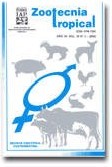
|
Zootecnia Tropical
Instituto Nacional de Investigaciones Agrícolas Venezuela
ISSN: 0798-7269
Vol. 27, No. 4, 2009, pp. 427-436
|
 Bioline Code: zt09045
Bioline Code: zt09045
Full paper language: English
Document type: Research Article
Document available free of charge
|
|
|
Zootecnia Tropical, Vol. 27, No. 4, 2009, pp. 427-436
| es |
Caracterización socioeconómica y tecnológica de los sistemas ganaderos en siete municipios del estado de Veracruz, México
Arroniz, Julio Vilaboa & Rivera, Pablo Díaz
Resumen
El objetivo del presente trabajo fue caracterizar los componentes tecnológicos utilizados en los ranchos ganaderos
(bovinos) y las características socioeconómicas de los productores ganaderos. Dicho estudio se realizó en siete
municipios de la región del Papaloapan, Veracruz, México: Alvarado, Azueta, Cosamaloapan, Ignacio de la Llave,
Ixmatlahuacan, Playa Vicente y Tlacotalpan que representan el mayor inventario bovino de la región (64%). Se
utilizó el método de la encuesta y la técnica de entrevista semi-estructurada a productores en las Asociaciones
Ganaderas Locales y en ranchos ganaderos de los municipios. Las variables incluidas fueron sociales, técnicas
y de comercialización. Se aplicaron 187 entrevistas, el análisis de cluster, estadística descriptiva y tablas de
contingencia. El análisis de conglomerados (cluster), de acuerdo a las variables consideradas, caracterizó tres
grupos de productores: tradicional, de transición y empresarial. La edad para estos grupos de ganaderos fue 53±13;
52±17 y 42±3 años, y las unidades animal por hectárea fueron 1,48±0,8; 1,2±0,8 y 1,35±0,4; respectivamente. En
general, la finalidad zootécnica fue ganado doble propósito (77%), con pastoreo extensivo a libre pastoreo (97%)
como el sistema predominante y un patrón racial de la cruza Suizo x Cebú (75%) como el más representativo.
Palabras-clave
caracterización de productores, bovinos, doble propósito, sistemas de producción.
|
| |
| en |
Socioeconomic and technological characterization of cattle based systems in seven municipalities of the state of Veracruz, México
Arroniz, Julio Vilaboa & Rivera, Pablo Díaz
Abstract
The purpose of this study was to characterize the technological components used in cattle ranches and
socioeconomic characteristics of the producers. The study was implemented in seven municipalities of the Region
Papaloapan, Veracruz, México: Alvarado, Azueta, Cosamaloapan, Ignacio de la Llave, Ixmatlahuacan, Playa
Vicente and Tlacotalpan that represent the largest cattle inventory in the region (63,6%). We applied surveys and
semi-structured interviews with producers Associations Local Livestock and cattle ranches. The variables were
analyzed socially, technically and marketing. We used cluster analysis, descriptive statistics and contingency
tables. The typology of the producer characterized as traditional, transitional and business. The age for these
groups or farmers was 53±13; 52±17 y 42±3 years, and animal units per hectare 1,48±0,8; 1,2±0,8 y 1,35±0,4;
respectively. In general, the aim was won zootechnical dual purpose (76,5%), with grazing for free grazing
(96,8%) as the dominant system and a pattern of racial crosses Swiss x Cebu (75,4%) as the most representative.
Keywords
typology of producers, Bovine, Dual purpose, Production Systems.
|
| |
© Copyright 2009 - Zootecnia Tropical
Alternative site location: http://www.sian.inia.gob.ve/repositorio/revistas_ci/ZootecniaTropical/ztindice.htm
|
|
